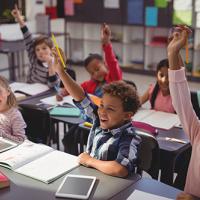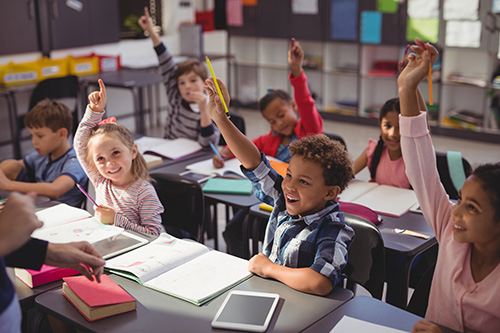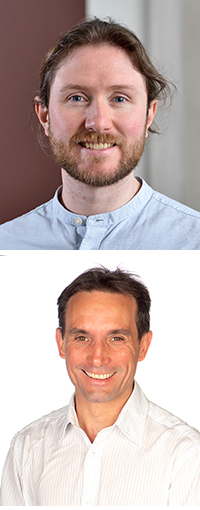
Keeping schools open in the next pandemic
Brief summary
This article explores what kind of information epidemiologists need to avoid full school closures during the next pandemic. Mostly this consists of information about social contacts within and outside of schools, which would feed into mathematical models of how a disease spreads. Gathering this information requires the participation of schools, students and parents.
One of the toughest restrictions during the COVID-19 pandemic were the school closures. Apart from disrupting students' education, there's evidence the closures also impacted their physical and mental health in ways that may last long into their future. Parents struggled with the interruption of the services that schools provide, such as free school meals and supervision of children. And as with other aspects of the pandemic, poor families were hardest hit. Overall it's not clear whether the benefits of closing schools outweighed the costs.
Hotbeds of infection
Blanket school closures were a blunt tool employed during an emergency. The reason was that schools have long been known to drive the spread of infectious diseases. "Because we put a lot of kids into the same classroom, and because their immune systems are still figuring out the world, kids tend to catch everything going," says Jonathan Read of Lancaster University and member of the JUNIPER partnership of disease modellers. "Schools serve to amplify the infection such that it can then spread out into the community."
A clear example of this came during the swine flu pandemic of 2009. The epidemic wave died out with the school summer holidays, but rekindled in the autumn. There's also other evidence confirming that schools play an important role in epidemics.
When the next pandemic comes around it would be useful to have less draconian measures at our fingertips. These might include a targeted use of testing, mask wearing, or clear policies about ventilating classrooms and hygiene. Stronger measures might include halving school days and/or staggering them. A staggered start of term might also help, since pressure to come in even when sick looms largest on the first day of school. It might also be worth revisiting the concept of bubbles, where only some students and staff remain at home while the rest continue their work and study.
"There's got to be something better than having schools fully open, with all the implications for public health, or fully closed, with all the societal, educational and economic harms," says Read. "But what exactly is that half-way house? At the moment, nobody knows."
Mathematical help
The good news is that to figure out which measures might work best, you don't need to try them out in practice, at least not initially. Epidemiologists like Read build mathematical models which describe, in the language of mathematics, how a disease might spread through a population. The models can be used to simulate an outbreak on a computer. Crucially, they can be used to simulate how an outbreak might play out with different measures in place. In this way you can get a sense of the impact of, say, a testing regime and how it would compare to other measures.
Mathematical models can never capture all that is going on in reality, and they come with varying levels of uncertainty. Used discerningly, however, they can be our best tools for exploring the scenarios that might arise with different interventions. Modelling was used extensively during the COVID-19 pandemic, for example to see what impact the then newly invented lateral flow tests would have on transmission in schools.

How can we avoid full school closures during the next pandemic?
"Ultimately we would like to use models to test how effective different school control measures are at reducing infections in schools and in the community," says Trystan Leng of Imperial College London, who was involved with the study on testing mentioned above and is also a member of JUNIPER. "But we would also like to quantify a wider range of impacts, for example on absences of students and teachers, on educational outcomes, and on the services the schools provide."
Ideally, mathematical models might suggest what Leng calls "silver bullet strategies" which stem the spread of the disease and simultaneously reduce pupil absences. If such silver bullets don't exist, then the models can at least help us weigh up the benefits and harms of different interventions.
Promising measures identified through modelling could be trialled in "peacetime", before the next pandemic strikes, and at the same time help with the seasonal outbreaks that plague us every year. "We do get outbreaks of seasonal infections every year and they can cause lots of people to be off sick all at once," says Read. "Anything that works in a pandemic should also work with outbreaks of common respiratory viruses or things like norovirus. So there's lots of opportunity to test these interventions ahead of time."
Data, data, data
The tricky part is that infectious disease modelling requires an awful lot of information. This is where everyone involved with schools — students, teachers, and parents — can give some vital help.
We know that schools drive epidemics, but to get a better sense of their exact role we need more baseline data: to see which students (e.g. which ages) tend to get infected by what virus and when. Because most common diseases aren't severe in children, GP and hospital records are of no use here. The only way to get at this data is to observe schools."I would love to see some over-winter observational studies in UK schools," says Read. "I've been involved in one study in the US where we were doing this in a few schools. If children were ill then they and their family members were chased up by a nurse with a swab to find out exactly which virus they had. This also told us how likely children were to transmit to their household."

Such data helps to quantify the risk that schools pose compared to other settings. But it's not enough to simulate the spread of a disease using a mathematical model. To do that, you need to know more about who interacts with whom — after all, it's through social contacts that diseases spread.
Information about contact patterns usually comes from surveys which ask people to report on the number and nature of contacts they have had, say, in the last 24 hours. It's also possible to use devices that detect when people are close to each other, a bit like the UK COVID-19 app did during the pandemic. The anonymised information is then aggregated and fed into infectious disease models, for example in the shape of average contact rates between particular age groups.
Such contact surveys have also been carried out in schools (see here for an example Read was involved with). But yet more data is needed. "We know a fair bit about how children interact when they are in school, but it would be useful to know more about the sub-settings that they interact in: to what extent they interact in classes, during the breaks, after school, with children from other schools, and the rest of the community" says Leng. "These could all make a big difference to the impact of interventions."
Apart from social contact patterns and networks of schoolchildren, there are also other things epidemiologists would like to consider to improve the models and develop robust and practical guidance. "For example, it would be useful to know how different the transmission risk is in different settings within a school: is it more risky to make a contact in a large classroom or in a small assembly hall? And how can ventilation and changes in airflow in each of those spaces impact transmission?"
"Not all schools are the same of course, each school has its unique characteristics and serves a unique community," says Leng. "But it would be good to have a sense of just how different all those different schools are."
This information would help epidemiologists figure out the types of mathematical models they need to accurately simulate disease outbreaks in schools across the country. "For example, it may be possible to model primary schools as a space where all kids in a classroom mix fully with each other, while a secondary school has more subtle structure due to the social groups the pupils form with each other," says Read.
Citizen science
The need for data is the reason that epidemiologists like Leng and Read would like to see more studies in and with schools. Their appeal goes to funding bodies, to provide budgets needed for such studies. But it also goes to schools, students and their parents, to consider taking part if they are approached: whether it's sharing individual data through contact or infection surveys, or sharing information about schools as a whole, such as physical lay-outs and organisational practices.

A lot of the information that's needed is private and no student or parent can be forced to give it up. Like all scientists who work with people, epidemiologists are bound by rules. "We have independent ethics boards at our universities which decide whether what we are intending to do is ethical, taking the view of the participants," says Read. In particular, epidemiologists must anonymise the information they collect as much as possible without destroying its value, and they most certainly are not allowed to share it with third parties.
"The most important part is to engage with schools and bring them along on the way," says Leng. "To find out what their concerns are and amend protocols on the basis of these concerns."
Ideally, any study would be a collaboration between epidemiologists, teachers, students, and parents. Not only because consent is vital, but also because the true experts in all things schools are the people who study and work in them. Indeed, a new paradigm called co-production is currently establishing itself among scientists of all kinds, not just in epidemiology. The idea is that researchers and the public work together on research projects "in equal partnership for equal benefit", sharing power from the beginning to the end of a project. (You can find out more on the website of the Co-Production Collective.)
The benefits of studies can indeed go both ways. Back in 2010 we reported on a research project designed by colleagues of Leng and Read, which doubled up as an educational experience for the students who took part. It gave them a first-hand taste of what it's like to do scientific research. In 2018 an impressive 30,000 volunteers from the general public signed up for a project developed by epidemiologists and the BBC, whose aim was to collect data about people's social contacts and movements. The result was a BBC 4 documentary about infectious disease modelling as well as a state-of-the-art data set for epidemiologists to use.
This kind of science may be serious and hard, but it can also be fun and rewarding. And the results may help soften the blow when the next pandemic strikes.
About this article
Trystan Leng is an infectious disease modeller based at Imperial College London’s Department of Infectious Disease Epidemiology. His research has assessed interventions aimed at reducing the transmission of gonorrhea, HIV, and SARS-CoV-2, and more generally he is interested in understanding how the structure of models impacts their predictions.
Jonathan Read is an infectious disease epidemiologist, based in the medical school at Lancaster University. He was member of SPI-M-O, the modelling group that advised the UK government during the pandemic, and has been involved in epidemiological studies in several countries, including USA, China, Malawi and UK.
Leng and Read were co-organisers of the workshop Infectious Disease Dynamics and Control in School Settings along with Sam Moore (Lancaster University). The workshop took place in November 2024 and was a JUNIPER Partnership activity, funded by the Isaac Newton Institute for Mathematical Sciences network support grant.
Marianne Freiberger, Editor of Plus, interviewed Leng and Read in December 2024.
This article is part of our collaborations with JUNIPER, the Joint UNIversities Pandemic and Epidemiological Research network, and the Isaac Newton Institute for Mathematical Sciences.
JUNIPER is a collaborative network of researchers from across the UK who work at the interface between mathematical modelling, infectious disease control and public health policy. You can see more content produced with JUNIPER here.
The Isaac Newton Institute for Mathematical Sciences is an international research centre and our neighbour here on the University of Cambridge's maths campus. You can find all the content from the collaboration here.
